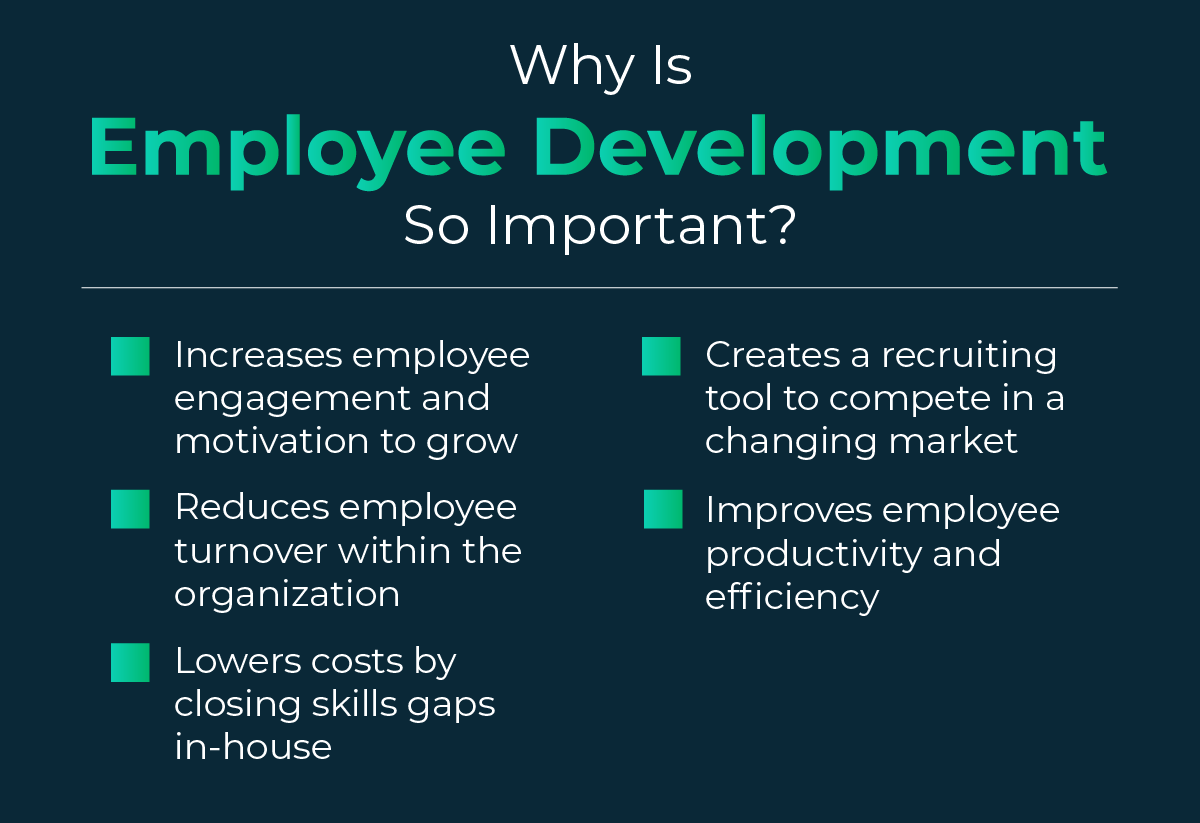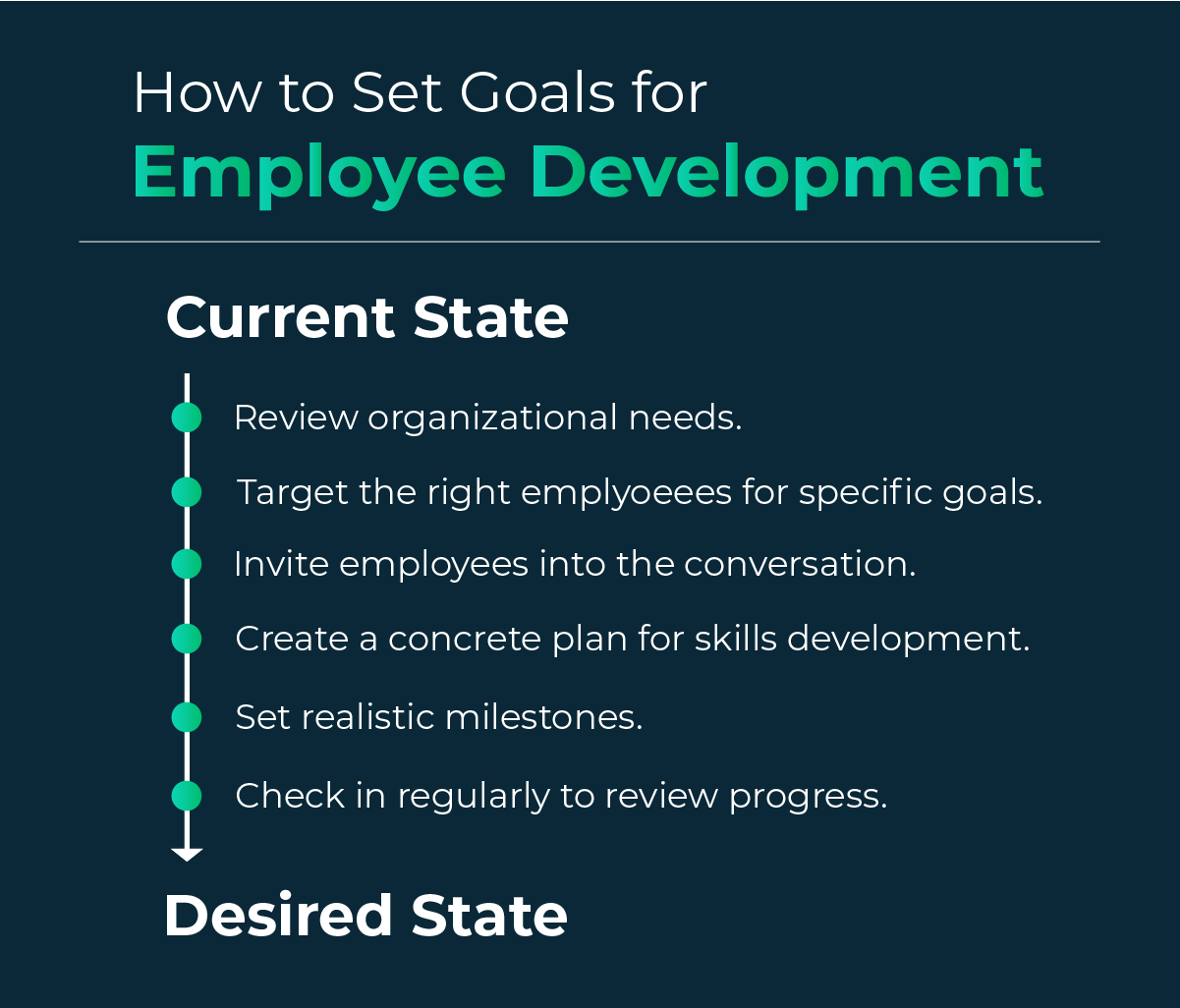Setting Employee Development Goals: Why They Matter for Your Team

In today’s competitive labor market, few companies have the luxury of simply adding staff to meet evolving business needs. The skills companies need are rapidly shifting as technology changes, and more and more roles are evolving to demand additional expertise in emerging fields and subject matter.
While employee development has always been important to the health of organizations, these macroeconomic factors have made it an imperative. Yet far too many companies continue to miss the opportunity to set and benefit from transformational employee development goals.
As you very well may know, when we use the term employee development, we refer to the process through which employees grow their existing skills and knowledge and build new competencies to take on new responsibilities and build their careers.
In today’s world, employee development can take many forms. These include formal training programs and informal learning opportunities and often involve upskilling and reskilling, especially within organizations where hiring employees isn’t an option.
Why Is Employee Development Important for Your Workforce?
Thoughtful employee development programs are essential for companies to stay competitive in today’s market. Key reasons why employee development is important include the following.
1. Increasing Employee Engagement
When employees believe their company values their work and growth, they are more likely to feel connected to the company and their colleagues, which impacts everything from their output to their health.
2. Reducing Turnover
Turnover is costly both financially and in terms of productivity, and offering employees growth opportunities can help companies minimize it. In fact, 94% of employees say they will stay with a company longer if it prioritizes their development.
3. Creating a Recruiting Tool
In today’s competitive hiring market, companies that offer employees development opportunities have an advantage in recruiting top talent.
4. Improving Productivity
Increased engagement boosts productivity. And when employees have the skills they need to do their jobs effectively, their performance is likely to improve.
5. Reducing Costs
In addition to saving on hiring, companies that develop employees from within can save significantly on external consultants by filling skills gaps in-house.
How to Set Employee Development Goals for Your Team
It’s clear why employee development is important for both individual employees and companies. But how can organizations effectively set development goals for employees?
1. Review Organizational Needs
Effective employee development plans align with the interests of the company–and individual employees–to maximize benefits. Before organizations embark on employee development plans, they should ensure development goals also address legitimate company needs. Conducting a skills gap analysis can help identify those growth areas.
2. Target the Right Employees for the Right Goals
Companies should also consider which employees to target for certain kinds of development. Ideally, all employees will have some sort of development plan, but efforts aimed at specific outcomes—perhaps leadership development or technical expertise—should target employees with demonstrated interest and talent.
Organizational leaders should work closely with line managers to identify those employees and engage them in the planning process.
3. Invite Employees Into the Conversation
Gaining employee buy-in is key to ensuring engagement in the development process. Managers should start development conversations with their direct reports early in their tenures at a company and keep them informed of business priorities that may affect their development plans. Regular conversations about employees’ short- and long-term interests and aspirations offer an opportunity to further identify areas of alignment between personal and company goals.
4. Create a Plan for Skills Development
Once managers have worked with their reports to reach a clear and achievable set of goals for employee development, they need to make a plan for building the necessary skills. Depending on the type of skills they are targeting, common options include internal mentorship or job rotations, external training programs (like those Emeritus offers), or even long-term college degree programs.
5. Set Realistic Milestones
No employee can transform into a leader or develop a new competency overnight; upskilling and reskilling are processes that take considerable time and effort. Breaking down larger goals into smaller milestones can help make the process feel more manageable and create space for adjustments if needed.
6. Check in to Review Progress
Regular check-ins between management and employees can help ensure they address any obstacles or sticking points before they become true problems. These touchpoints also offer the opportunity to course correct if the employee’s or company’s needs or goals change.
Ideally, managers should share what they learn in implementing employee development plans with their colleagues so that the company can iterate and refine its development practices.
Employee Development Goals Examples
Employee development goals can differ significantly in their scope and specifics based on the level and responsibilities of their roles as well as business needs. Potential examples include:
- Learning a new programming language
- Improving soft skills (like communication and collaboration)
- Preparing to present at an industry conference for the first time
- Taking on responsibility for a new product line
- Completing a leadership training course before managing a direct report
- Improving time management by utilizing a new project management methodology
While the specifics of goals will vary, it’s important to ensure they are clear, measurable, and actionable.
How to Help Employees Achieve Development Goals
Setting goals and providing resources to employees is a great start. But even high-potential employees, who are likely already working to their full capacity, need ongoing support to meet their development goals.
58% of employees would likely leave a company without professional development, according to The Conference Board.
While the type of support needed will vary based on the individual and the specifics of their role, several key strategies can help most managers support their employees’ needs.
1. Keep the Lines of Communication Open
In addition to performance reviews, ensure employees have the opportunity to speak up if they have concerns about their development plans or their day-to-day workload. Employees who don’t feel comfortable sharing their struggles may be more likely to look for a new role elsewhere instead of resolving those concerns with their manager.
Setting up standing weekly or biweekly meetings between managers and their direct reports is one way to provide that space.
2. Protect Employees’ Time
If employees are overstretched in their day-to-day roles, they can’t realistically be expected to also devote time to developing or improving their skills. Managers should work closely with employees to manage workloads and protect specific blocks of time for development activities like attending online classes or working on assignments. This may require temporarily reducing output goals or pausing other projects.
3. Be Ready to Pivot
While carefully planning for employee development is important, flexibility is just as crucial. When company priorities or employee needs shift, managers must be prepared to respond, whether that means identifying an alternate path toward shared goals or adjusting those goals due to changing circumstances. As always, thoughtfully communicating changes to employees is essential to success.
Employee development requires careful planning and attention, but when done right, the results can be transformational for both individuals and the business. By prioritizing development and supporting employees throughout the process, companies can improve engagement and outcomes.
Looking for courses designed to support your employee development goals? Contact us to learn how Emeritus Enterprise can design and develop online employee training programs tailored to your company’s needs.






